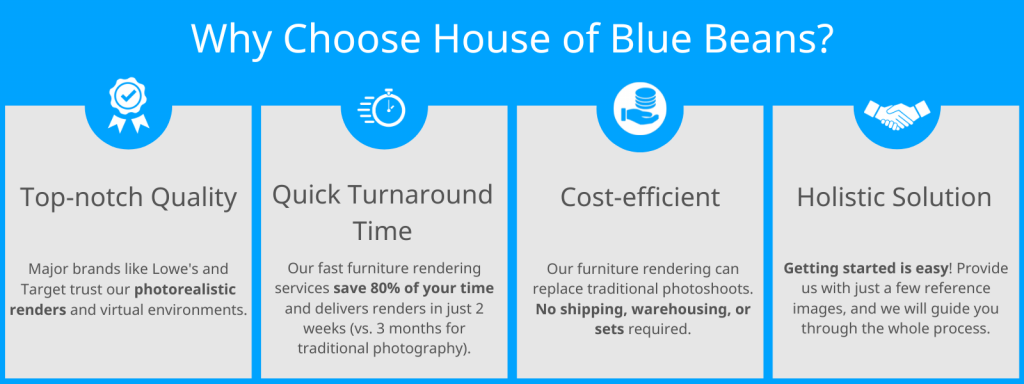Do you want to avoid flat, uninspired product images that fail to capture the true essence of your brand? Do you want to showcase your products in a way that truly captivates and engages your customers?
House of Blue Beans’ high-quality 360 product photography via CGI will capture the product from every angle and detail and give your customers an immersive experience!
Imagine you’re looking to buy a new pair of shoes online. You’re browsing various websites, trying to find the perfect pair, but you can only see a handful of images from several angles.
There are questions that are unanswered, like:
- What do these shoes look like from the side?
- What are the dimensions?
- What do they look like from the back?
- How is the texture?
- How intricate are the patterns?
- What is the quality of the product’s material?
Making a purchase decision is confusing when you don’t understand the product clearly.
That’s where 360 product photography comes in. It’s a game-changer for online shopping, enabling customers to interact with products as if they were physically present in a showroom or holding the item themselves.
360 product photographs give customers a comprehensive view of the product from every angle, making it easier to understand its features, design, and functionality.
So, if you’re a business looking to increase engagement and sales, 360 product photography is the way to go. It provides transparency and interactivity that normal photography can’t match.
By giving your customers a more comprehensive view of your products, you’re building trust and confidence in your brand, which can lead to increased customer satisfaction and loyalty.
This blog guides you through the ins and outs of 360 product photography, including its benefits, the steps involved in the process, and how House of Blue Beans can be your ideal partner for this innovative technique.
What Is 360° Product Photography?
360-degree product photography is a photographic technique where a series of photos gives an impression of the product rotating—also referred to as 360 spins, spin photography, or 360 packshot photography. That means it simulates holding the product in their hands and looking around at different angles, sometimes zooming as well.
To create 360 spins, a series of photographs are taken at different angles and then stitched together using specialized software into a 360°view.
Products with intricate details and unique features can be made interactive using 360 product photography. This technique is commonly and majorly used in eCommerce or online retail stores where customers can’t touch the product, but they need to get a better sense of the product to make an informed decision.
What Are The Different Types Of 360 Product Photography?
It is important to understand the different types of 360 product photography as this will help understand which approach is best for which product, situation, or application. For instance, non-interactive 360 animations can be used in virtual tours or product demos for complex and detailed products. Interactive 360 animations, on the other hand, can be used in virtual events, eCommerce, and real estate to offer immersive and interactive visual content.
- Non- interactive 360 spin: The type of 360 product photography wherein the image sequence is pre-determined. The product is captured in 24 camera angles at every 15 degrees (in some cases 36) to provide a seamless turntable experience. This will be a simple interactive experience that allows the user to rotate the product on one axis.
- Interactive 360 spins: A 360 interactive experience is a real-time experience where the 3D model of the product is hosted on the product page. In this case, the viewers will be able to view the product from any angle and rotate the product on either axis allowing for more freedom to explore the product. Viewers can use zoom capabilities with the click of a mouse and drag feature. It allows consumers to interact and experiment on-page with products and various hotspots.
- Single-row photography: It includes fixing the camera in one position and rotating it 360 horizontally to get a complete product view.
- Multi-row photography: Multi-row photography includes stitching together two or more rows of single product photography to capture a complete view of the product horizontally and vertically.
- Object photography: Object photography captures the minute details of small objects like jewelry, watches, and small gadgets. The object is placed on a turntable, photographed from different angles, and is stitched together to create a 360 view.
- Virtual Tours: This type of photography combines multiple images to provide viewers with an immersive and interactive experience through a virtual environment where they can navigate.
- Time-lapse photography: It includes capturing a series of images over a period and then stitching them together to create a 360 time-lapse video.
360° Product Photography Use Cases
Imagine your customer is shopping online for a new pair of shoes. They find a pair they like, but your website only has one photo of the shoes from the front. They can’t see what the back, sides, or bottom look like. They have to guess what it looks like from that photo and hope they fit and look good when they arrive. This is what happens in normal photography.
Now, imagine your website offers 360-spin product photographs. If your customers click on the same pair of shoes instead of just one photo, they can rotate it 360 degrees, zoom in to see the texture of the leather, the stitching, or the details on the sole. They can see what it looks like from every angle, as if they were holding them in their hand.
That’s the magic of 360 degrees product photography. It’s like having the product in front of you, but better because you can see it from every angle without leaving your house. And it’s not just for shoes – 360-view product photography can be used for all kinds of products, from clothing to electronics, home decor, and sports equipment.
Are your customers looking for a sturdy helmet? With 360° product photography, your customers will be able to see not only the helmet’s design, size, and features but also the ventilation system, the padding, and the strap style. This will be especially helpful to bike riders or skiers looking for a helmet that fits well and offers adequate protection.
Are your customers shopping for a new sofa? They can see photos of the couch from the front, but what about the back? Is it comfortable? Is it the right size for your space? With 360 product photography, they can see the sofa from every angle and even zoom in to see the fabric up close. Before buying it, they can see what it would look like in their living room.
Or imagine they’re shopping for a new phone case. Your customers can see photos of the case from the front, but what about the sides? Does it fit snugly around the buttons and ports? With 360-spin product photography, your customers will be able to rotate the case to see every angle and ensure it suits your phone perfectly.
So, whether your customers are shopping for shoes, sofas, or phone cases, jewelry, 360 product photography ensures that all details are noticed and they get a complete picture of the product. It’s like having X-ray vision for products – they can see everything and ensure they get precisely what they want.
Now that you have enough examples to understand how 360-degree product photography via CGI can enrich the customer experience, you must wonder whether or not your product will benefit from 360 product photography. We have compiled a list of questions t0 help you determine the answer.
- Does the product have features or details that might not get covered in a normal/one photograph?
- Are you offering a high-end product?
- Is the product designed for use in different positions and angles?
What Are Some Of The Standard Terms Used In 360 Product Photography?
Like any technique or technology, certain terms are associated with 360-degree product photography that enhances collaboration and communication between various professionals involved in the 360-degree photography process.
- Stills: They are individual photos taken at different angles around the object. They are captured at a specific point in time and from a particular angle using a 360 camera. These stills are then stitched together to provide a panoramic image or video.
- 3D spin: When two or more rows of still images are positioned at a certain angle in a manner that they showcase a 3D product experiencing displaying both horizontal and vertical axis, that is called 3D spin.
- 3D model: When a series of photos are stitched together either using photogrammetry scanning or the 3D model is hand modeled using a skilled 3D artist and specialized software, it forms a 3D model.
- Turntable: This is a rotating platform where the product is kept and photographed from different angles in normal photography methods.
- Hotspots: These are specific interactive points on which viewers can zoom in and pan around to learn detailed information about the product.
Normal Images Vs. 360° Product Photographs
360-degree product photography offers a more detailed, informative, and interactive way of enhancing a customer’s journey. Certain factors can be crucial in deciding why 360-degree product photography is the right choice.
- Interaction: Normal photography only captures the product from a few angles, limiting the customer’s ability to see the product from different perspectives. In contrast, 360 product photography allows customers to rotate and zoom in on the product, providing a more immersive and interactive experience.
With normal photography, customers may rely on written descriptions and reviews to understand the product thoroughly. With 360-view product photography, customers can see the product for themselves, making it easier to make an informed purchasing decision.
The high level of interactivity makes 360 product photography different and better than normal photography. Since 360 product photography allows customers to rotate the product and see it from any angle, they better understand its appearance and features.
- Engagement: Unlike normal photography, where customers can see the product only from certain angles, it is difficult for them to decide whether they should purchase the product. This is not the case with 360 product photography, it allows customers to explore the product from different angles. This increases their interest in the product and boosts engagement.
- Product understanding: Normal photography captures the product from only a certain angle, making it difficult for the customers to completely understand the features and functionality. But 360 product photography offers a comprehensive view of the product, providing the customers with details on size, shape, texture, and other intricate details. This is especially helpful with products that have a complex design, like electronics or jewelry.
- Purchase decisions: A still image from normal photography is not enough for customers to make a sound decision regarding the purchase. 360 product photography, on the other hand, provides a comprehensive view of the product from all angles, which helps the customer understand how will the product look and feel in real life. This results in informed decisions making and reduces the likelihood of abandoned carts, returns, or exchanges. Furthermore, 360 product photography also helps increase the website conversion rate since a better understanding of the overall features and functionality of the product boosts customers’ confidence and trust in the brand, which intensifies sales.
- Online visibility: 360 product photography lets customers view the product from different angles using the zoom-in, zoom-out, rotate, and pan features. Enhancing customers’ shopping experience with immersive 360 product photography proves critical in grabbing customers’ attention and getting your product noticed, thus increasing online visibility.
How Does 360 Product Photography Make A Difference?
360 degrees product photography has the ability to make a product stand out from the crowd by offering an informative and immersive product journey to the customers. The following are the ways in which 360-degree product photography makes a difference:
- Increase your website conversion rate: 360 Degree product photography provides high-quality and detailed images of the products, which helps build customers’ confidence in the brand. This is especially important in the case of online shopping, where customers can not physically touch the product. By providing an engaging, accurate, and immersive representation of the product, 360-degree product photography can improve customer experience, boost engagement, improve the bounce rate, and thus boost sales.
- Increased customer engagement time: With 360 product photography, customers can interact with the product by rotating and zooming in on different angles. This interactive experience makes it easier for them to understand the product, leading to increased engagement, which encourages customers to stay a little longer on the website, thus increasing the possibility of sales.
- Increased customer confidence: Customers purchase a product only when they clearly understand its features and quality. Product photography 360 degrees provides transparency that helps build trust and confidence in the product. 360 product photography provides a detailed, accurate, and high-quality representation of the product. By giving the customers the freedom to view the product from a different angle, rotate them, zoom in and out, and pan them, brands help in whichever way they want to get complete details on the features and functionalities of the product to build a trustworthy customer base. This increase in confidence results in repeat purchases.
- Reduced product returns: 360 product photography leads to improved product information and better product visualization. When customers better understand the product, they are less likely to return it due to unexpected features or design flaws. This reduces the overall cost of product returns for businesses. Since they can better understand whether or not the product will suit them, this will reduce the change of returns or exchanges.
- Gives you a competitive advantage: By using 360 product photography, businesses can differentiate themselves from normal product photography competitors. This can attract customers who value a more immersive and interactive shopping experience.
360 Product Photography: How House Of Blue Beans Can Help?
House of Blue Beans (HOBB) is your one-stop solution for all 3D visual content- including 3D asset creation, product visualization, architectural visualization, and AR/VR. We have been assisting leading brands like Lowe’s, Target, Honeywell, and many Fortune 50 companies in bringing their ideas to life through immersive and attractive visualization.
HOBB 3D artists use CGI to bring your product to life through a 360 spin or 360 interactive in a cost-effective, scalable manner with a quick turnaround time. We aim to help boost your sales by providing your customers with high-quality 360 product photography.
Our team of experts uses cutting-edge software and techniques to create stunning 3D models of your products, which are then animated to create images from different angles. We convert these images into a 360 product view easily embedded on your website or e-commerce platform.
Our process is highly collaborative, and we ensure that your vision for your product is fully realized. We can create 360 product photography for various products, from simple items like shoes and jewelry to complex machinery and equipment.
We use a specialized process at HOBB to create high-quality product photography 360 degrees. Here is how we carry out the process of 360 product photography creation:
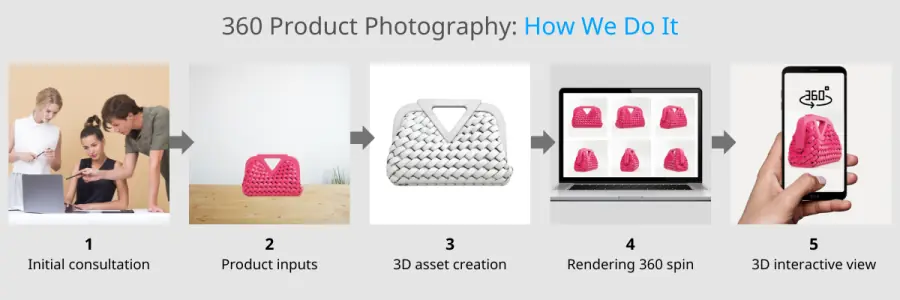
- Initial Consultation: Upon selecting HOBB’s 360 product photography service, our team initiates the process with an initial consultation. We discuss your product and specific requirements to ensure a customized approach to your project. To contact us, visit our website and provide basic details about your requirements. Our team will promptly reach out to you to discuss your project further.
- Product Inputs: Once we clearly understand your products and specific requirements, our team of experts will request a few inputs from you in the form of product images, brand direction & SOW document. These images may include shots from the back, side, and front, as well as close-up details and dimensions.
Suppose you are a furniture marketer or an e-commerce website specializing in selling furniture and wish to promote your line of chairs. In that case, the following product images would be required from you:
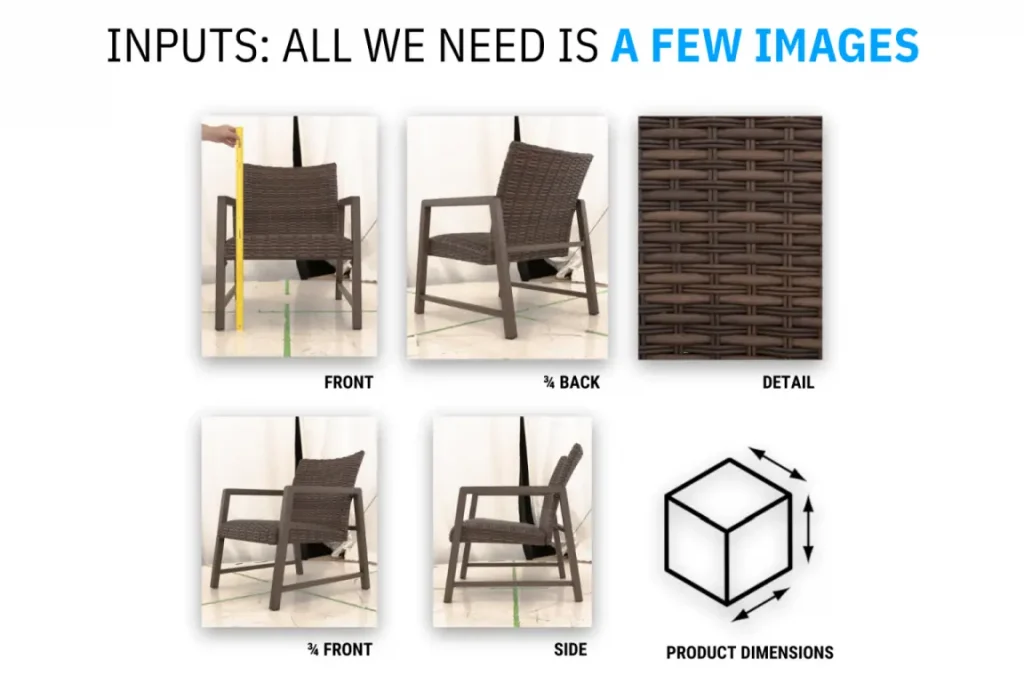
- Creating 3D Asset: Our team of experts uses specialized software to create a photorealistic and the highest quality 3D model of your product (here, chair). These assets are scaled-down 3D virtual copies of the product. This model includes all the intricate details and features of the chair, such as shape, texture, and color. We see every detail closely to ensure the model is as accurate and realistic as possible. The visual content and templates are then created per the direction of the creative team & clients’ inputs.
Adding textures and lighting: Once the 3D model is created, we add textures and lighting to create a lifelike image of the product. This process involves choosing the appropriate colors, materials, and lighting to accurately represent the product’s features and design.
Animating the 3D model: Using the software’s animation tools, we create images that capture the product from different angles. This forms the basis of the 360 product view.
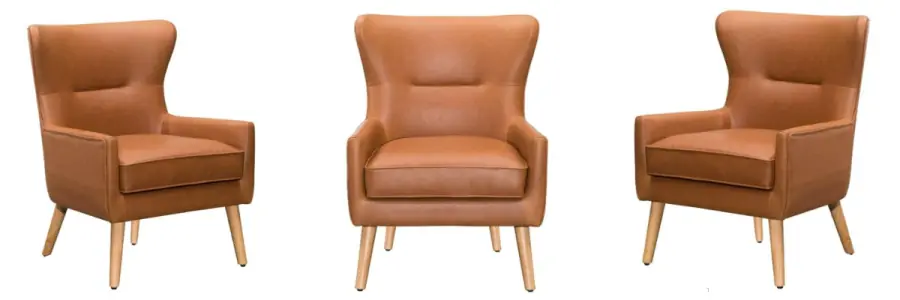
4. Rendering the 360 spins: We then render the product from 24 different camera angles, thereby covering the product at every 15 degrees sequentially. All 24 images are stitched in a sequence animation to create a high-quality, realistic image sequence that can be displayed on the product page or any other relevant destination. This process can take time, depending on the complexity of the product and the level of detail in the animation.

5. Creating a 3D Interactive view: We host the 3D model on a product viewer that allows the end user to interact with the product by rotating it on any axis along with zoom options. The product viewer is usually embedded into the product page to allow interaction with the end user. We use cutting-edge technology and techniques to create indistinguishable visuals from real-life products. This attention to detail ensures that our client’s products and services are showcased in the best possible light.

If you’re curious why you should choose us over the many options available, consider our track record of working with prestigious clients. We have consistently exceeded our client’s expectations for ten years by understanding their requirements and delivering exceptional projects. Our success is reflected in our growing reputation, and we take pride in continuing to excel in our field.
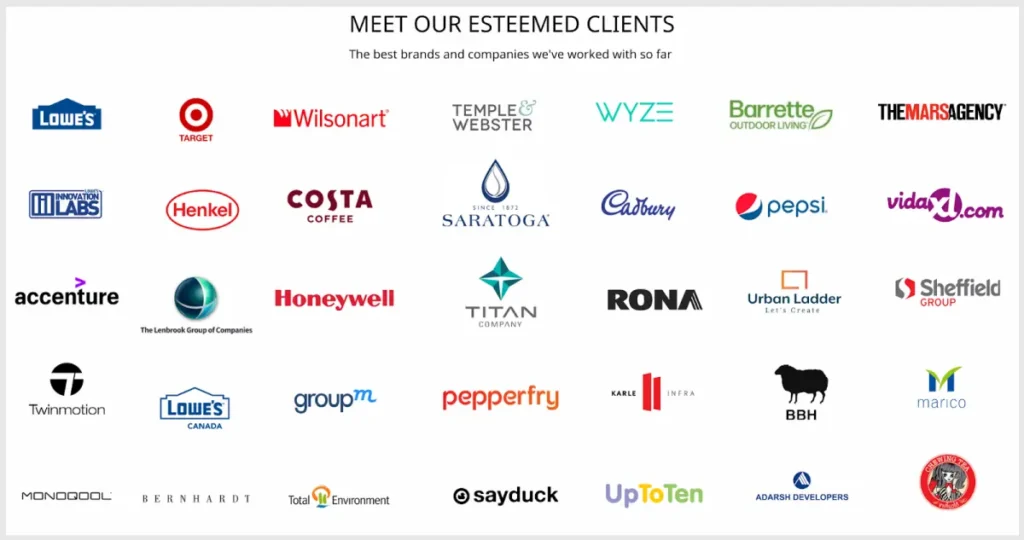
Not only have we had the pleasure of collaborating with excellent clients, but we have also received acknowledgment for our efforts. Please take a moment to peruse our reviews.
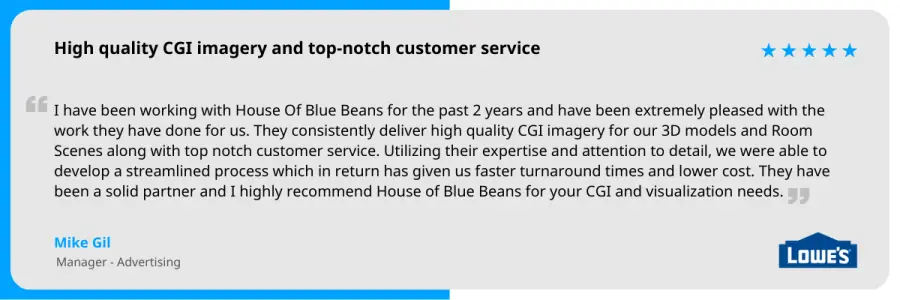
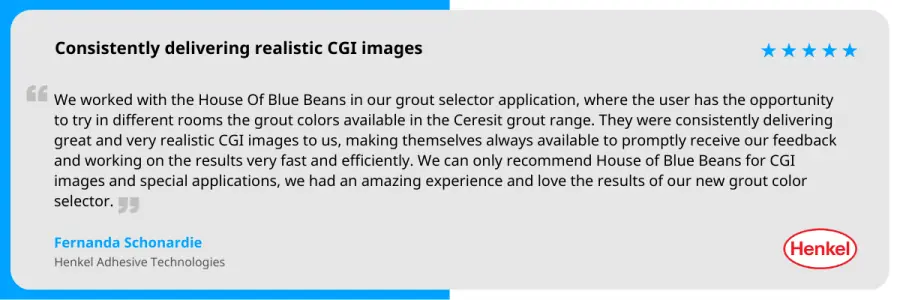
How Much Would A 360-Degree Product Photography Service Cost?
The cost of availing 360-degree product photography largely depends on the following factors via traditional photography:
- Type of product: Is the product complex? What is the size of the product? Will a turntable be enough, or will it require special props? Products that are intricate and require props or lighting may be costly to photograph.
- The volume of the work (number of SKUs): How many products are you planning to get photographed? While certain photographers may offer discounts on the service, the more the number of products, the higher would be the cost.
- Logistics: Will the photographer have to travel and set up a special studio? Will it require handling insurance? The location and need for any special equipment will increase the cost. In general, images created via CGI would always be much more cost-effective as they can be done remotely.
- Type of Photography: Do you want a basic 360-degree spin or complex and interactive 360-degree photography? The type of photography you plan to proceed with will impact the cost.
- Image Resolution: Higher-resolution images may take more time to process and require more equipment. This can add to the cost.
The aforementioned factors make the normal photography method costly as well as time and resource-extensive. This is not the case with using 360 product photography using CGI.
360 product photography using CGI can capture images from all different angles without requiring physical products. This can be especially helpful when there is a need to photograph heavy products that are difficult to transport.
Flexibility: With 360 product photography via CGI, you can create multiple product images from various angles and different variations. For instance, online sellers and marketers may require multiple photo shoots for an eCommerce website which is easy to generate via CGI. 360-degree photography via CGI captures the product image from various angles, eliminating the need for additional detail shots, thereby significantly reducing the overall cost associated with photography.
Cost-effective: 360 photography via normal photography requires specialized equipment which can burn a pocket hole. This is not the case with 360-degree product photography via CGI, which only needs a turntable, camera, and basic lighting equipment.
Since no physical samples are involved, it eliminates the cost of storing, shipping and displaying products. Furthermore, since 360-degree product photography via CGI is done remotely, there is no need to build expensive setups.
Let Your Product Speak For Itself
In conclusion, 360 product photography showcases your products in an immersive and interactive way. By allowing customers to view products from every angle, companies can increase engagement and sales while providing a more engaging and enjoyable shopping experience.
With the continued advancement of technology and the increasing demand for online shopping, 360 product photography will likely become an even more important aspect of eCommerce. If you want to grow your online presence, increase customer engagement and stand out from the competition, 360 product photography is your best shot.
At House of Blue Beans, we pride ourselves on delivering exceptional quality and service. Our team ensures that every project is completed to the highest standards and on time. So, if you want high-quality 360 degrees of product photographs for your business, House of Blue Beans is here to help. Reach out to us today to learn more about our services that can help you take your online presence to the next level and boost your sales.
